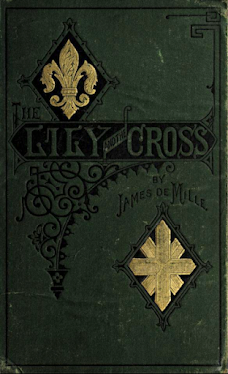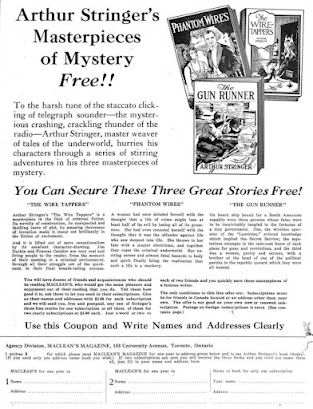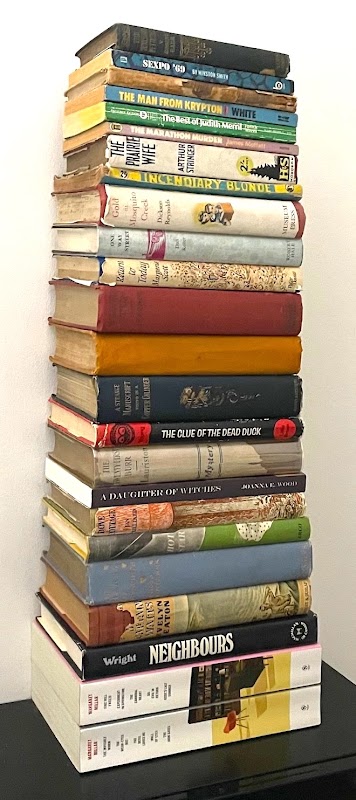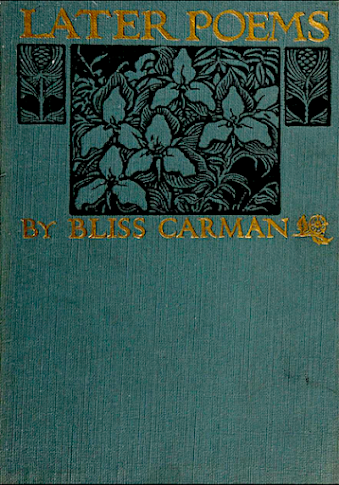You Never Know Your Luck: Being the Story of a
Matrimonial Deserter
Gilbert Parker
Toronto: Bell & Cockburn, 1914
328 pages
The dust jacket invites comparison with The Right of Way, Gilbert Parker's 1901 runaway bestseller, but I would have gone right ahead regardless. Both novels centre on married men who, brought down by vice, go missing. In The Right of Way that man is Charley Steele, Montreal's most feared lawyer and closet drunkard. Whatever you may think of him, Charley is not a matrimonial deserter. What happens is that he goes slumming, gets into a bar fight, and receives such a blow to the head that he loses his memory. It takes the talents of a world-renowned French surgeon to set things right, by which time the lawyer has been declared dead and his wife has remarried.

It is a story of redemption. Charley does not return to Montreal, his mansion, his vast wealth, and his beautiful wife. He'd married Kathleen for her looks, but she is now wed to a man who loves her back. Charley recognizes the private pain and public sensation that would result in reappearing Lazarus-like.
Shiel Crozier of You Never Know Your Luck is a lesser man. He begins the novel as J.G. Kerry, living a modest life in an Askatoon (read: Saskatoon) boarding house run by young Kitty Tynan and her widowed middle-aged mother. Shiel's true identity, that of a married Irish baronet, is revealed through his testimony as witness to a murder involving the Macmahon Gang. Gus Burlingame, the lawyer for the defence, holds a grudge. He was turfed from the boarding house after Shiel caught him groping Kitty.
 |
| Munsey's Magazine, April 1914 |
Pretty Kitty has a thing for Shiel. It's easy to see why. Handsome, personable, fun, and smart as a whip, he's seems the most eligible bachelor in Askatoon – that is until Burlingame gets him on the stand and has him disclose that he has a wife overseas. Before Kitty can digest the revelation the Macmahon Gang strikes again! This time, the target is Shiel himself. He survives a gunshot to the gut through the good work of the local physician, known affectionately as "the Young Doctor."
 |
| Munsey's Magazine, April 1914 |
While recovering, Shiel summons the doctor, Kitty, and Mrs Tynan to his bedside, where he expands upon the revelations revealed during the trial. The scene, which takes the entirety of the sixth chapter, is depicted in two not dissimilar illustrations by George Wright (above) and William Leroy Jacobs (below).
 |
You Never Know Your Luck
Toronto: Bell & Cockburn, 1914 |
Shiel speaks of his privileged birth, his education at Eton, his education at Oxford, and his education at London's Brooks's Club, where he was introduced to the Crozier family's long history of placing wagers on just about anything. Taking up the tradition, Shiel starts on a track that will lead to the loss of his inheritance, but not before he marries heiress Mona (maiden name not provided). His bride had encouraged him to change his ways. Shiel promised he would, only to bet the last of his fortune on a horse named Flamingo at Epsom Downs. What happened next was tragedy, no doubt inspired by Emily Davison's death at the 1913 running.
 |
| The Daily Sketch, 7 June 1913 |
Like George V's Anmer, Flamingo was brought down by a woman stepping onto the racecourse, though this action had nothing to do with the Suffragette cause.
In an instant, Shiel is rendered nearly penniless. Because he hasn't the fortitude to face his spouse, he makes for the colonies, but doesn't escape before receiving a letter from Mona. Shiel's been carrying it, unopened, ever since.
The Right of Way ranked amongst the ten bestselling novels in the United States in both 1901 and 1902. It was adapted once by Broadway and thrice by Hollywood.
You Never Know Your Luck didn't make nearly so big a splash, though there was a 1919 Sunset Pictures production starring House Peters and Mildred Southwick. Alas, 'tis another lost silent film. Very lost. The only image I've found comes courtesy of this advert in the 16 December 1919 edition of the Beaver, Pennsylvania Daily Times.
The reason The Right of Way did so well and You Never Know Your Luck not falls on Shiel's shoulders. He is a matrimonial deserter; there's no getting around this, it's right there on the title page.
The appealing, charismatic character we encounter in the novel's early pages is exposed on the stand. Though he's portrayed as having got the better of Burlingame when on the stand, he never managed to restore his reputation with this reader. And yet, Kitty's love endures, as does Mrs Tynan's. The novel's most interesting passage involves an awkward exchange in which daughter and mother reveal to one another that they are in love with the same man. Parker really pushes things when the deserted wife, still very much in love with her husband, arrives in Askatoon.
It is in Shiel that the fault lies.
Parker treads terrain that is similar to that of The Right of Way, but here his footing is nowhere near as sure. This time out, his hero is far too flawed.
The poorly composed seven-page epilogue – too wordy, too flowery – concludes with the marriage of the novel's most likeable character. It is not a happy ending. There's uncertainty, some of which stems from the fact that the groom has a vice of his own. And the bride? Well, she's in love with another man.
It's in these last few pages that the novel redeems itself.
Bloomer:
Object: Purchased seven years ago for six dollars, far more than I usually pay for a Parker; but just look at the thing!
First, there's the dust jacket, which has somehow managed to survive these last 110 years. Next we have four colour plates and illustrated endpapers by William Leroy Jacobs.
Access: You Never Know Your Luck first appeared in the April 1914 edition of Munsey. Much was made of it at the time.
Munsey provides nineteen illustrations, the first depicting Kitty Tynan:
My Bell & Cockburn edition is the Canadian first. Torontonian George H. Doran published the American first. Online seller Babylon Revisited Rare Books, whom I've dealt with in the past – and so, can recommend – has the two best copies on offer. Both Doran firsts in uncommon dust jackets, they're going for US$85.00 and US$125.00. Condition is a factor. The only Bell & Cockburn edition is offered by a Manitoba bookseller. At US$6.00, it is also the least expensive.
Related post:























































